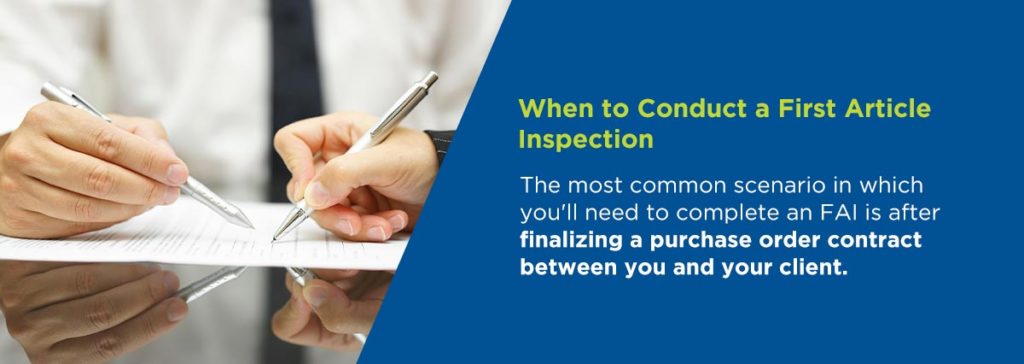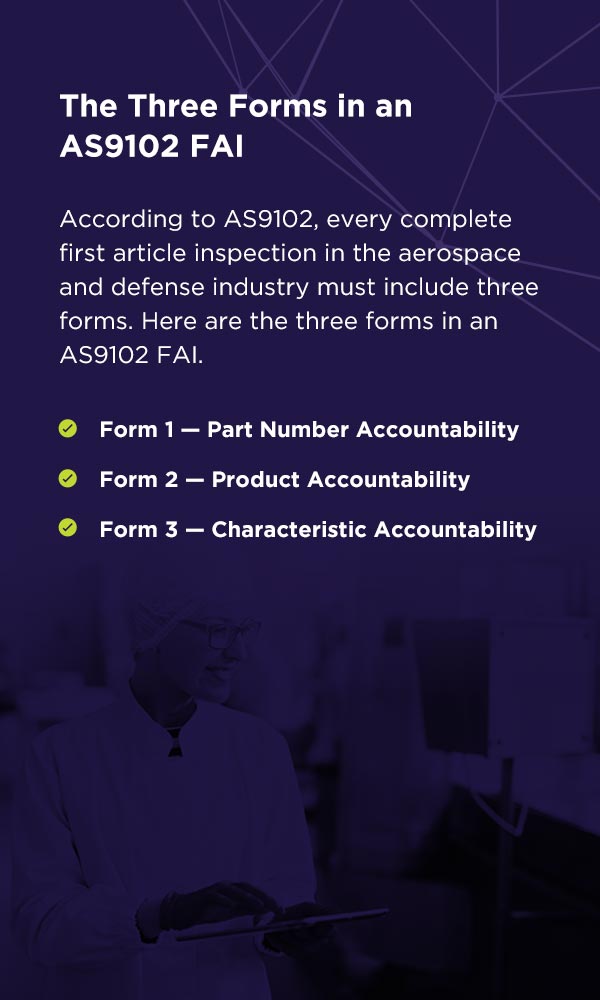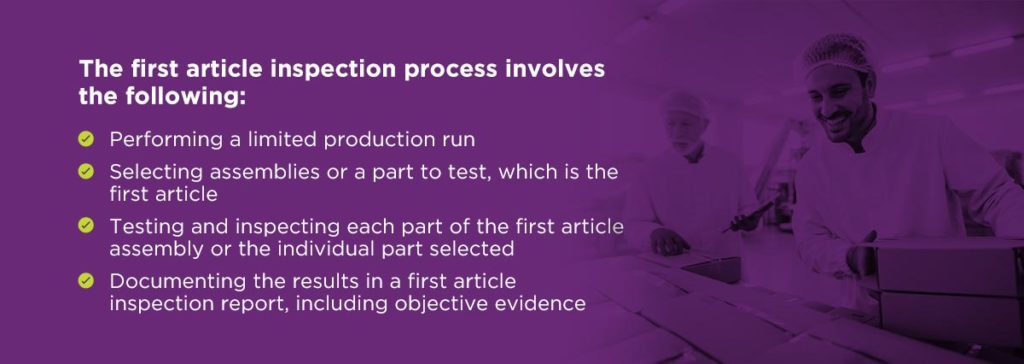In the aerospace and defense industries, maintaining quality products is essential. Your clients will use your products in mission-critical products, and often, people’s safety, well-being and mission success will be on the line. With this in mind, you can understand the importance of ensuring you’re producing products that work as intended for each of your clients’ specified requirements.
You need to be sure your manufacturing process creates repeatable, conforming products. Your clients want the confidence that they can trust your products to fulfill their requirements and on-time goals. To achieve true product compliance, stability and accountability, you need to complete and document the first article inspection (FAI). An FAI is a baseline measurement of your processes, a crucial part of your quality control plan, so it’s vital to document it properly.
What Is AS9102 First Article Inspection?
The AS9102 is the detailed process that allows manufacturers and clients to capture the product requirements, inspect and document all product features and document the materials and processes used in manufacturing that product or assembly. The AS9102 report form ensures the product aligns with the client’s specifications. Every product properly documented with an AS9102 FAIR becomes a record of the product conformance before full-scale production and at given intervals to establish consistency. A quality manager can use an AS9102 FAI as part of their inspection plan, determining that future manufacturing runs of a specific product will maintain the same high levels of quality and compliance.
To further understand what an AS9102 FAI is, you need to know the definition of a first article. The term applies to a product selected from your manufacturing process’ initial production run. If this first article passes its inspection and meets the client’s criteria, your manufacturing company must consistently use all the same processes in the future.
When conducting an FAI, you’ll choose one sample part, usually at random, from this initial production run. The first article represents the culmination of your production process, which includes all the steps, machinery and tooling needed to create a functional and satisfactory product for your client. Ideally, the first article will be the “gold standard” that represents what your manufacturing process can do, according to your planning and implementation.
A proper AS9102 first article inspection is more than a simple quality control test, though it does aid in this insight. When you conduct an FAI, you’ll take measurements, perform tests and show that you’ve met all client specifications required. After completing the FAI and determining that your processes are repeatable, consistent and statistically controllable, you can know for sure that your future production runs will achieve the same desired results.
In short, the first article inspection acts as a quality control inspection for your product and a way to verify your manufacturing process.

When to Conduct a First Article Inspection
There are specific instances when you must conduct a first article inspection to ensure characteristic accountability of your manufactured products. The most common scenario in which you’ll need to complete an FAI is after finalizing a purchase order contract between you and your client. In most cases, the buyer will require a first article inspection in the purchase order contract to ensure the product meets their specifications. This contractual approach verifies manufacturers understand the requirement and can produce a product that successfully meets the customer’s specifications.
The Society of Automotive Engineers provides other examples of when you would need to conduct a first article inspection, such as after the following.
- The first production run of a new product: Before producing something for the first time, complete an FAI to ensure it meets all your criteria.
- Implementing a change in a product’s design: Changes in design can be more than cosmetic. After altering an item’s design, a first article inspection is necessary to ensure it was created as specified.
- Changing the sources or materials used in producing a product: Changing the materials you use in a product or the parties from which you source them can impact functionality. Performing an FAI after making such a change will help you maintain a consistently high level of quality for your customers.
- Two years have passed since the initial product run: Staying abreast of your production performance, tooling and special processors is a crucial part of quality control and meeting your customers’ needs.
- Any change in tools, processes or location of manufacturing: An FAI ensures your products meet your customers’ criteria, but it also reveals whether your manufacturing process can maintain consistent quality. If you change any part of your process, including the location or tools, you must conduct another first article inspection.
The Importance of First Article Inspection
Here are some reasons a first article inspection is essential to any successful manufacturing run.
- Product quality: An FAI represents the finished product’s quality. If the FAI reveals problems, nonconformances or shortcomings, you’ll know you need to adjust your production processes. The completed FAIR verifies you have met your clients’ requirements.
- Process quality: Besides informing you of product conformity, a first article inspection will validate the manufacturing process itself, ensuring you can duplicate the results your client is looking for. Performing an FAI will let you know if you’re ready to engage more product runs or if you need to make any tweaks to your manufacturing process to achieve more desirable results.
- Documentation and tooling: A first article inspection also verifies the material and special process documentation, in addition to the tooling you use throughout your manufacturing process, thus ensuring you have objective evidence of the product conformity. Having authenticated FAI documents on hand gives you the information you need about your process when you need them — for example, in postmortem reviews and evaluations — benefiting you and your clients alike.
- Buyer and manufacturer peace of mind: You and your client want certainty throughout the transaction. Your client deserves assurance that their product is going to meet their specifications. You need faith that your process will yield the desired results during the current and each future manufacturing run. A first article inspection will give you and your client the definitive proof you need to move forward with the process.

The Three Forms in an AS9102 FAI
According to AS9102, every complete first article inspection in the aerospace and defense industry must include three forms. You should familiarize yourself with these so you can better know what to expect from your first article inspection and what you’ll be responsible for doing and providing throughout the inspection process.
Here are the three forms in an AS9102 FAI.
- Form 1 — Part Number Accountability: Form 1 includes all the information needed to describe the assembly or part that the FAI is verifying. Included is all applicable documentation, product serialization, revision levels, part names, part numbers, organizational name and an assembly parts list that includes traceable information. Lastly, Form 1 includes the completed first article inspection report or approval information.
- Form 2 — Product Accountability: Form 2 will capture materials, special processes and functional testing applicable to the first article part or assembly. List these in chronological order as they appear in the manufacturing process. At a minimum, the Material Cert packages will consist of the Material Supplier C of C and the Manufacturer’s Cert and Test Report. Form 2 addresses all materials, special processes and specifications where subsequent monitoring or measurement cannot verify the resulting output. If you use a substitution material or special process per customer substitution documentation, record that information on Form 2. Maintain and furnish evidence of traceability between the material cert and work order or traveler.
- Form 3 — Characteristic Accountability: Form 3 includes the evaluation and verification of every identifiable characteristic of the product, like performance and dimensional requirements. Form 3 will include test or inspection results for each of these characteristics. An example is gauge identification for demonstrating that you met every product requirement in the first article sample. Form 3 also includes any instances of either party accepting or identifying any nonconformances.
FAI packages should include bubble drawings, model screenshots or sketches denoting design characteristics and a parts list showing all the unique part characteristics, including all drawings plus general and flag notes. This information must include your approval and traceability to the authority dataset. The unique characteristic accountability must correspond with a unique identifier on the bubbled drawing, sketch, screenshot or a link to a CMM report.
Other crucial components of an FAI package include:
- Material certifications
- Process certifications
- Completed FAI forms
- Nonconformance documents
- Test reports or results
- Casting or forging approvals
- Completed work order and any re-work orders representing the manufacturing process, as required
- Copy of the customer condition of supply, as required
- Customer approval of frozen planning outside data sheet (outside processor) or manufactured engineering planning instruction control number
- Supplier information requests
- Other fabrication records as indicated in CMM reports such as point maps and setup instructions, as required
- Along with the part number, log a unique identifier on the supporting documents, such as an FAI report number or manufacturing process reference number
How to Create a First Article Inspection Report
Now that you understand more about first article inspections and the forms that you need for a completed first article inspection report, it’s time to learn how to create one for yourself. Handling your FAIRs yourself could be a convenient and cost-effective option for you, though it will demand more work on your end than having a third party handle your first article inspection needs. Here are the five steps you must take when creating a first article inspection report for your processes.
- Plan your first article inspection: To start, you must gather all the documents needed for a successful FAI. These include digital product information, engineering drawings, data sets, specifications, materials lists, work orders, manufacturing planning documents and sourcing information. For your FAIR, you’ll also need to prepare the three forms listed in the previous section.
- Create an inspection plan: In this step, you’ll create an itemized drawing with numbered “balloons” that point to individual dimensions and part requirements. These numbers correlate to those listed on Form 3. You’ll also prepare your AS9102 forms according to the information required for each.
- Manufacture your first article: You will then perform your initial production run to acquire your first article for inspection. Be sure to document the process and inspection results. Remember that the first article does not have to be the initial item you produce. It can be anything selected from the first production run.
- Collect data: For this step, you will use the inspection plan from step two to inspect the first article accordingly. Be sure to keep track of your certified, calibrated inspection tools. You may need to trace these tools back to the people qualified to use them to perform the inspections or manufacture the first article accurately.
- Create your report: Finally, you will create your first article inspection report. Enter your results into AS9102 Form 3. Include the serial numbers of used tools, a functional test report, measured results, any applicable nonconformance information and a certificate of conformance.

The First Article Inspection Process
In short, the first article inspection process involves the following:
- Performing a limited production run
- Selecting assemblies or a part to test, which is the first article
- Testing and inspecting each part of the first article assembly or the individual part selected
- Documenting the results in a first article inspection report, including objective evidence
The inspection process helps the involved parties verify the product’s functional and physical characteristics against specifications, drawings, design documents and purchase order information. This information will go on the first article inspection report at the end of the process. Here is some of the information that must be on a completed FAIR:
- Revision level
- Parts numbers and descriptions
- Any applicable drawing numbers
- The customer’s purchase order number
- The name and signature of the person completing the first article inspection
- The date of the completed inspection
- Proof of the customer’s approval
- The review of the process(es) and materials
- Functional test methods and results
- The COC number
- The measurement of the product’s physical characteristics
Follow the five steps of creating a first article inspection report and be sure to include all the information listed above to ensure valid results in your product’s first article inspection.
How Unitek Technical Services Can Help
Unitek Technical Services is ready to help you with your first article inspection needs. Our expert services are available for any stage of your manufacturing process, including creating and implementing your first article inspection report. We understand the importance of product verification for your business and how proper inspections and verifications can help you improve your product quality while reducing costs. That’s why we want to share our expertise with you as you seek a successful first article inspection for your product.
You and your business as a whole have a lot to do as you plan your upcoming product manufacturing run. We can help enhance your back-end operations so you can stay focused on your core competencies and whatever else matters most to you in achieving your business goals. We offer rapid, scalable and efficient technical support services to help you keep up with your supply chain needs as you validate your suppliers’ quality through first article inspection.
Whatever your needs, we can help you stay engaged with the tasks that matter most.
Contact Us Today
NTS Unitek has been helping businesses like yours achieve smoother back-end operations for decades. We’ve grown over the years to offer an ever-expanding range of management and technical support services across industries, with a specific focus on the aerospace and defense industries. Our experience sets us apart, and we want to share our resources and exceptional, proven approach with your business to help you achieve new heights of success.
We’re ready to help you comply with standards and consistently apply procedures and policies to add value to your offerings and maximize your return on reinvestment. Contact us today for more information.

